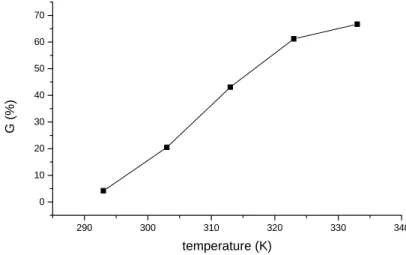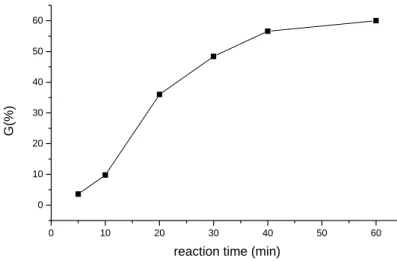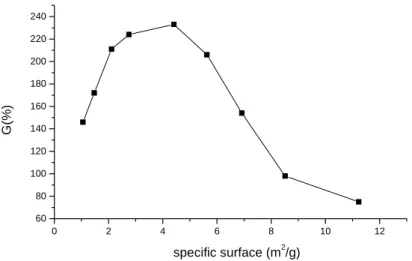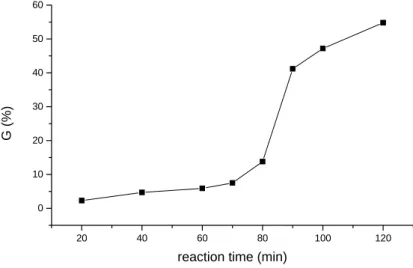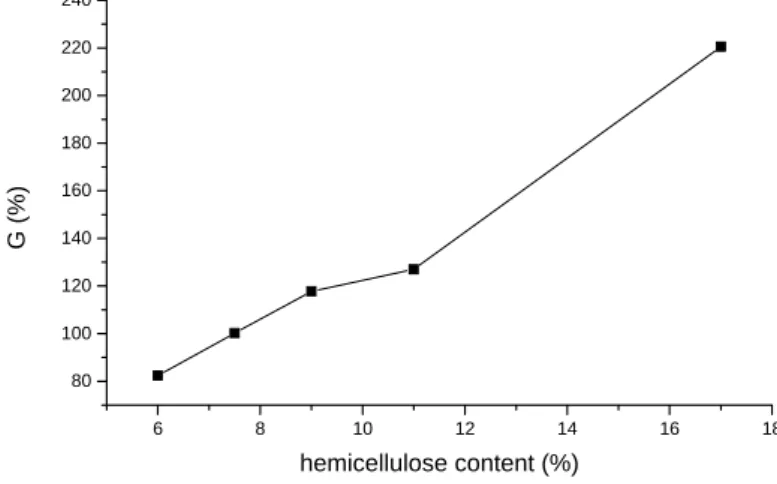Grafting of Industrial Cellulose Pulp with Vinyl acetate Monomer by Ceric Ion Redox System as Initiator
Éva Borbély,* József Erdélyi**
* associated professor of Budapest Polytechnic, Dept. of Packaging and Paper Technology
**professor of Budapest Polytechnic, Dept. of Packaging and Paper Technology H-1034 Budapest, Doberdo 6.
Abstract: The Ce4+/ Ce3+ redox system was studied to initiate the grafting of idustrial cellulose pulp with vinyl acetate monomer. The parameters of the copolymerization reaction (reaction time, temperature, monomer and initiator contentration, freeness, chemical composition of the cellulose) were investigated and their effects are discussed.
Keywords: cellulose, copolymerization, vinyl acetate, ceric ion redox system, parameters.
1. Introduction
The chemical modification of cellulose by graft copolymerization has generated interest among researches because few comonomer molecules change significantly a number of characteristics of the original natural polymer. Thus new areas of the application might be opened for the modified cellulose-type materials.
Being a polymer itself, cellulose can be copolymerized only with block or grafting procedures. The block copolymerization of cellulose essentially modifies its physical structure, and therefore cannot be used. A graft copolymer is a system comprised of a backbone material to which a second polymer is attached at intervals along the chain. The pulp cellulose modified by grafting copolymerization does not change its fibrous structure, which is very advantageous for further use.
Most of graft copolymerization examined so far [1,2,3,4,5,6] described the use of cotton or regenerated cellulose as the substrate, and there are only few papers about the grafting of cellulose pulp used in the paper industry [7]
Recently we examined the grafting of industrial cellulose with vinyl acetate monomer initiated with cerium(IV)salts [8]
The rather complex action of Ce4+on cellulose can be formulated so:
(1)
2. Experimental
The graft copolymerization was carried out in a 500 cm3, three-necked, round flask equipped with a mechanical stirrer, a reflux condenser and a thermometer, which was immersed in a thermostat water bath. First the definite amount of cellulose was pulped for 30 minutes, then the required concentrations of cerium- ammonium-sulphate initiator solution and vinyl acetate monomer were added sucessively to the reaction system. At the end of the reaction time we stopped the reaction by L-ascorbic acid.
After the completion of the reaction, the rough products were first precipiated in an excess of acetone and then separated by filtration. To obtain the pure graft copolymer, we used carbon-tetrachloride to extract the homopolymer that might be produced during the polymerization. Extracting for 6 hours was sufficient to remove the polyvinyl acetate homopolymer.
Then the graft copolymer was dried in the air to a constant weight. On the basis of gravimetric measurements, the grafting parameters were determined as follows:
⋅ 100
= −
o o p
W W
G W
(%) (2)⋅ 100
= − M
W
GM W
p o (%) (3)paper are not improved sufficiently, if it is too big, the pulp becomes unsuitable for paper making.
2.1. Effect of temperature and reaction time on grafting efficiency
As the rate of chemical reactions can be regulated with variation of temperature, experiments indicated that an inccrease in the temperature had a very strong effect on G % (Fig.1) At 20 oC (293 K) there was practically no reaction. Increase the temperature improved G % dramatically, but the difference between 50 and 60 oC (323 and 333 K) was only a few percent. This latter can be explaned by the low boiling point (72,3 oC) of the monomer. From these results, 50 oC (323 K) can be proposed for the grafting temperature of this system.
290 300 310 320 330 340
0 10 20 30 40 50 60 70
G (%)
temperature (K)
Figure 1. Effect of temperature on grafting efficiency
As to the time dependence of the grafting reaction, G % increased rapidly in the first 40 minutes of the process (Fig.2.). Longer durations did not significantly improve the efficiency of grafting.
0 10 20 30 40 50 60 0
10 20 30 40 50 60
G(%)
reaction time (min)
Figure 2. Effect of reaction time on grafting efficiency
2.2. Effect of initiator concentration on grafting efficiency
Graft copolymerization was studied at various cerium-ammonium-sulphate initiator concentration (10-3 - 5.10-3 mól/dm3) (Fig.3.).
20 30 40 50 60 70 80 90
G (%)
with increasing initiator concentration may be ascribed to the increase of active sites on the backbone of the cellulose fiber. The retarding effect of G% with initiator concentration beyond 2.10-3 mól/dm3 may be due to predominancy of homopolymerization over grafting and termination of growing grafted chains by excess of primary radicals formed from the initiator. From these results 2.10-3 mól/dm3 cerium-ammonium-sulphate can be proposed for the optimal grafting efficiency.
2.3. Effect of monomer concentration on grafting efficiency
G% depends, first of all, on the applied monomer concentration. The change in G% as the function of the monomer amount at a fixed initiator concentration (2.10-3 mol/dm3) is shown by a curve with a maximum peak (Fig.4.). This maximum occured because over a given concentration the termination is preferred reaction among other reactions. 1 mol/dm3 vinyl-acetate concentration can be proposed for the adequate grafting efficiency.
0,2 0,4 0,6 0,8 1,0 1,2 1,4 1,6 1,8 2,0 2,2 20
30 40 50 60 70 80 90
G (%)
monomer concentration (mol/dm3)
Figure 4. Effect of monomer concentration on grafting efficiency
2.4. Effect of freeness on grafting efficiency
Graft copolymerization occured on the surface of the pulp, so the efficiency of grafting depends strongly on this surface. Increasing the pulping time the freeness and the externel specific surface of the cellulose is increased ( Table I. and Fig.5.)
Pulping time (min) Freeness (SRo) External specific surface (m2/g)
0 15 1,056 10 20 1,472 20 22 2,112 30 27 2,752 40 34 5,632 50 44 8,512 60 56 11,232 Table I. Effect of the pulping time and freeness on the specific surface of the
cellulose
0 10 20 30 40 50 60
0 2 4 6 8 10 12
specific surface (m2 /g)
pulping time (min)
Figure 5. Effect of pulping time on the specific surface of the cellulose The change in G% with increasing the specific surface of the cellulose is shown by a curve with a maximum peak (Fig.6.).
0 2 4 6 8 10 12 60
80 100 120 140 160 180 200 220 240
G(%)
specific surface (m2/g)
Figure 6. Effect of specific surface on grafting efficiency
Increasing the specific surface of the cellulose increased G %, but after 5 m2/g grafting efficiency decreased. This latter can be explaned by the decrease of the amount of radicals formed on the same surface at a fixed initiator concentration.
So the best grafting efficiency can be reached with 35 min pulping time, when the the specific surface of the cellulose was 4,4 m2/g.
2.5. Effect of chemical composition of the cellulose
The chemical composition of idustrial cellulose pulp has also a strong effect on grafting efficiency. Although G% depends, first of all, on the lignin content of the applied cellulose pulp only a few papers can be found about the investigation of this effect [9].
To decrease the lignin content of an unbleached cellulose we treated the samples in 5 steps with sodium hypochlorite for 5, 10, 30, 60 and 90 minutes. The change of lignin content during the bleaching time - measured with Kőnig-Komarov method - is shown in Table II.
Bleaching time(min) Lignin content(%)
0 12,0 5 10,3 15 5,8 30 3,5
60 2,1 90 0,5 Table II. Effect of bleaching time on lignin content of the cellulose After the bleaching treatment the cellulose samples were grafted with vinyl acetate for 40 minutes at three different temperatures applying the adequate monomer and initiator concentration (Fig 7.).
0 2 4 6 8 10 12
0 10 20 30 40 50 60 70 80 90 100 110 120 130 140
303 K 313 K 323 K
G (%)
lignin content (%)
Figure 7. Effect of lignin content of the cellulose on grafting efficiency Increasing the lignin content of the cellulose decreased G % and after 12 % lignin content the grafting efficiency becomes 0 %. This latter can be explaned by the inhibitor role of lignin in the grafting reaction /9/. The industrial cellulose which is suitable for grafting copolimerization may contain maximum 2 % of lignin.
To investigate the induction period of grafting reaction causing by the presence of lignin the cellulose sample which has the maximum lignin content (12%) was
20 40 60 80 100 120 0
10 20 30 40 50 60
G (%)
reaction time (min)
Figure 8. The induction period of grafting reaction causing by lignin Until 70 minutes there was practically no reaction, but beyond 80 minutes reaction time increased G % dramatically, so the induction period of grafting reaction in this case is seen to be between 70-80 minutes. This is in agreement with the results of other authors investigated the same problem [7].
The effect of hemicellulose content of the cellulose pulp was also investigated, but as it is shown in Figure 9. the change in grafting efficiency causing by the different hemicellulose content of the samples not so significant as the effest of lignin content of the same sample.
6 8 10 12 14 16 18 80
100 120 140 160 180 200 220 240
G (%)
hemicellulose content (%)
Figure 9. Effect of hemicellulose content of the cellulose on grafting efficiency At the end of our research work the unmodified and grafted cellulose samples were analyzed by IR spectroscopy, thermal analysis and scanning electron microscopy.
Conslusions
In this work the graft copolimerization of vinyl acetate onto industrial cellulose pulp by Ce4+/ Ce3+ redox system is characterized by maximum graft yield at varying temperature, reaction time, specific surface and chemical compositions of the cellulose and at different concentrations of monomer and initiator. This method is suitable for producing binder fibers applied in special synthetic papers.
References
[1] See, E..G.,Bains, M. S.: J. Poly. Sci. 1972. 37. p 125 – 182.
[2] Gupta, K. C., Sahoo, S.: J. Appl. Polym. Sci. 2001. 79. p 767 – 789.
[3] Flaque, C., Rodrigo, L.C., Ribes-greus, A.: J. Appl. Polym. Sci. 2000. 76. p 326 – 337.
[4] Abdel-Razik, E. A.: J. Photochem Photobio. 1993. 73. p 53 – 72.
